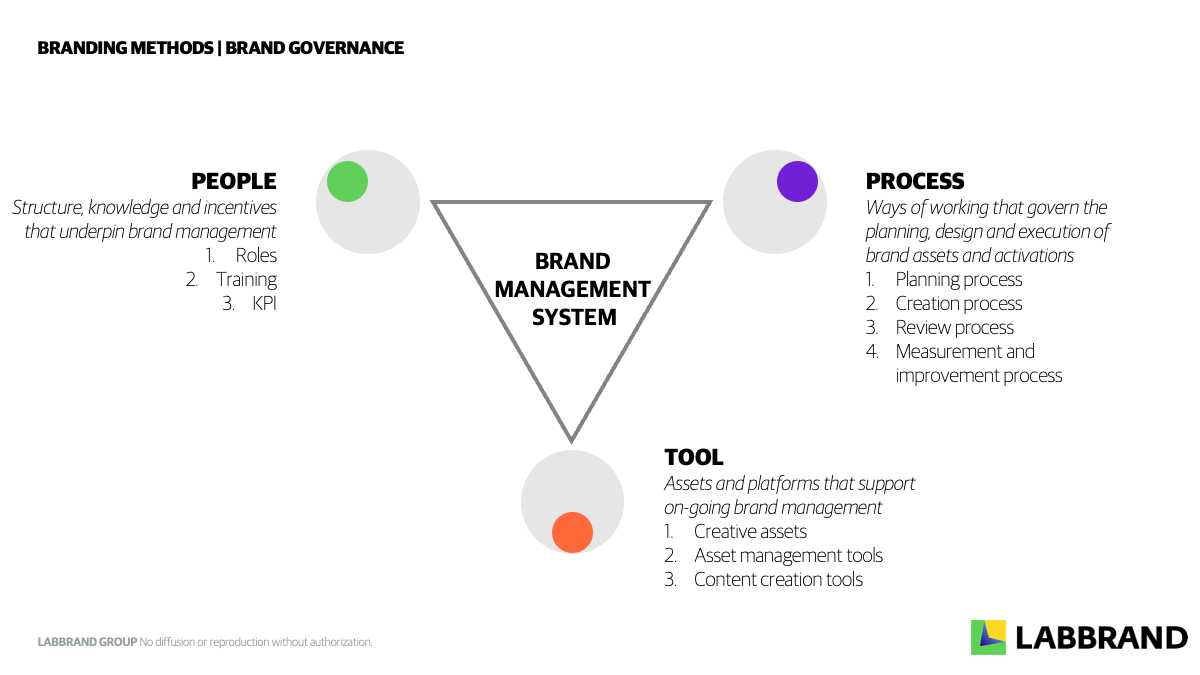

Brand success depends on sustained quality execution.A large majority of brand building investment is made towards brand definition, identity, and activation, including brand positioning, visual identity and media buying. However, a large proportion of this investment is squandered because of a lack of consistency and quality in brand execution. The solution to this problem lies in brand governance.
Brand governance, sometimes also referred to as brand management, is often narrowly understood as a brand police exercise consisting mostly of the monitoring of basic brand assets usage such as colors or logo. This view however is too narrow. We define brand management as a system of people, processes and tools that work in sync to ensure high-quality, consistent, and impactful brand delivery at scale and over time.
Such a definition gives us a full picture of the items that should be included in a brand governance strategy.

Brand governance reflects a company’s culture, business model and brand activation channels. As such, no two companies will have the same brand governance model. However, we can define metrics and stages for brand governance maturity.
There exists no formalized brand management system. Brand management is focussed on ad-hoc review of key assets and reactive management of brand delivery challenges.
There exists a basic brand management system focussed on ensuring conformity of key activations and assets with brand guidelines.
Brand management is a core function that spread across the entire organization, making agile, high-quality brand execution easy for all brand users.
Our own experience indicates that most brands currently stand at the ‘Control based brand management’ stage of brand management maturity, having in place the right setup to ensure basic consistency and guidelines conformity of brand activations. This model can be sufficient for certain companies. Others, especially in highly innovative B2C industries, face higher demands in terms of brand reactivity, coordinated cross channel execution and agile innovation. For these, a further step up to ‘360 brand management’ is necessary. Proceeding to the ‘360 brand management’ stage requires not just additional resources but a shift in focus from control to collaboration and empowerment.

PEOPLE
PROCESSES
TOOLS
As we see, brand governance is what embeds brand strategy within the organization, enabling the on-going coordination of brand activation in accordance with the brand’s vision. Without it, upstream strategy and identity work risks becoming a purely theoretical exercise with no concrete application. Absent brand governance, long term return from tactical brand activation investment, such as content production and media, will also be hampered by lack of consistency in the tone and quality of output.
Kevin Gentle
Managing Partner
A Labbrand Group Company © 2005-2025 Labbrand All rights reserved
沪ICP备17001253号-3To improve your experience, we use cookies to provide social media features, offer you content that targets your particular interests, and analyse the performance of our advertising campaigns. By clicking on “Accept” you consent to all cookies. You also have the option to click “Reject” to limit the use of certain types of cookies. Please be aware that rejecting cookies may affect your website browsing experience and limit the use of some personalised features.